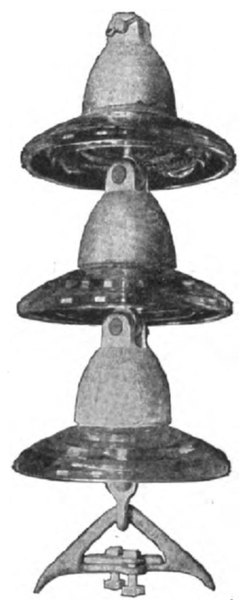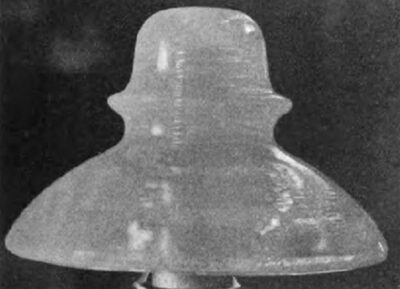[Trade Journal]
Publication: Electrical Record
New York, NY, United States
vol. 17, no. 6, p. 29, col. 1-2
Locke Boron-Aluminum-Silicate Insulator
A new line of insulating material composed of boron, aluminum, and silicon has just been put on the market by Fred M. Locke, of Victor. N. Y.
|
 |
| Boro-Porcelain and Boro-Silicate Insulators Fred M. Locke, Victor, N. Y. |
The material is fused together at extremely high heat, and formed into shape about the same as glass. It is strong mechanically, and shows great resiliency. Its dielectric constant is 4.8, while that of porcelain is 6.0. and glass 8.0. Its coefficient of expansion is low, being next to fused silica. It will stand big temperature changes without cracking. Its specific gravity is low. about 2.26.
The Locke 5A insulator, which is 5 inches in diameter and 3 ½ inches high, will stand an arc-over test of 75,000 volts, and a dielectric test of 140,000 volts. The thickness through the thinnest part does not exceed ½ inch. A porcelain insulator of the same dimensions will, it is said, stand an arc-over test of about 50,000 volts, and dielectric test of considerably less than 100,000 volts, separate adjustments, one for overload conditions at which it opens; the other is the dead load adjustment. By dead load adjustment is meant the adjustment for current which will flow at instant of reclosing. The dead-load setting is necessarily somewhat lower than overload setting, in order to prevent the breaker opening instantly after closing.
It is the ability of this type of breaker to distinguish between a legitimate load resistance of a low value, and an actual short circuit, which renders it a commercial success. In a number of installations where these breakers are used it has been found that the dead load consisting of lamp self-starting motors, etc., required a current at instant of closing almost equal to current at which the breaker was set to open.
A dash pot is provided so as to furnish a definite time interval between the opening and closing of breaker in case of momentary overloads, the object being to give starting box levers time to return to the off position before throwing the power back on the line.
The general appearance of these machines is shown in the annexed cut. All magnet coils and the dash pot are contained within a cast iron housing, thus being thoroughly protected mechanically. Sufficient heat is and free from moisture. The accompanying diagram shows the theory of operation of this device.

